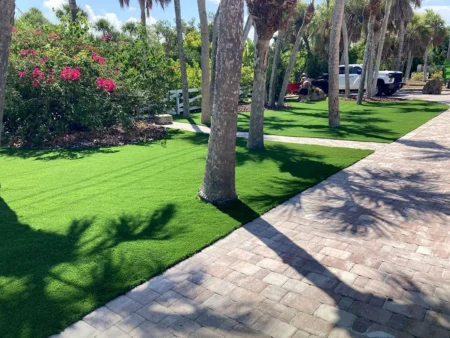
Water conservation is a pressing issue in many regions around the world. As urban areas expand and climates shift, the demand for water increases, putting pressure on this precious resource. One innovative solution that has been gaining popularity for its water-saving benefits is the installation of synthetic grass. This blog article explores how synthetic grass contributes to water conservation efforts in the Orlando area, offering insights into its advantages and the impact it has on the local environment.
The Need for Water Conservation
Orlando is known for its lush landscapes and vibrant green spaces. However, maintaining these verdant areas requires significant water usage, especially during the dry seasons. Traditional lawn care, including watering, mowing, and fertilization, contributes to a considerable amount of water consumption in residential and commercial properties. As water scarcity becomes a more pressing issue due to population growth and climate change, finding ways to reduce water use while maintaining green spaces has become a priority. This is where synthetic grass comes into play.
A Sustainable Solution
Synthetic grass, often referred to as artificial turf, is a water-efficient landscaping solution that mimics the appearance of natural grass without the need for regular watering, mowing, or chemical treatments. Made from high-quality, durable fibers, artificial turf provides a year-round green aesthetic that contributes to the beauty of landscapes while significantly reducing water usage.
Water Conservation Benefits
The primary advantage of synthetic grass in water conservation efforts is its minimal water requirement. Unlike natural grass, which needs regular watering to stay green and healthy, synthetic grass remains vibrant without the need for irrigation. This characteristic is particularly beneficial in Orlando, where water conservation is crucial during dry spells and drought conditions. By switching to synthetic, homeowners and businesses can save thousands of gallons of water annually, contributing to the region’s water conservation goals.
Environmental Impact
In addition to saving water, synthetic grass reduces the need for fertilizers, pesticides, and herbicides often used in traditional lawn care. These chemicals can leach into the groundwater, causing pollution and harming local ecosystems. By eliminating the need for these substances, artificial turf contributes to a healthier environment. Furthermore, since synthetic turf doesn’t require mowing, it reduces lawnmower carbon emissions, further enhancing its environmental benefits.
Implementing Synthetic Grass in Orlando
The City of Orlando and various local organizations have been encouraging the use of synthetic lawns as part of their sustainability and water conservation initiatives. Multiple programs and incentives are available to homeowners and businesses that choose to install synthetic, making it an accessible option for those looking to contribute to water conservation efforts.
Challenges and Considerations
While synthetic grass offers significant benefits in terms of water conservation and environmental impact, it’s important to consider some challenges. The initial installation cost of artificial turf can be higher than that of natural grass. However, the long-term savings on water bills and maintenance costs can offset this initial investment. Additionally, the quality and aesthetics of artificial turf have improved significantly over the years, making it a visually appealing option for many.
Synthetic grass stands out as a forward-thinking and environmentally responsible approach to addressing water conservation challenges. By significantly reducing water usage, cutting down the need for harmful lawn care chemicals, and lowering carbon emissions from lawn maintenance activities, artificial turf plays a crucial role in bolstering environmental sustainability efforts within the region. The growing acknowledgment of its advantages among Orlando’s communities is a testament to the broader acceptance of artificial turf as a vital component in conserving water and safeguarding the local ecosystem. This trend towards adopting artificial turf not only marks a significant stride towards a more water-efficient and eco-friendly but also underlines the community’s commitment to preserving its green spaces without straining its precious water resources. For those considering making the switch to synthetic grass, resources such as Artificial Turf Tampa offer valuable information and services to support this environmentally beneficial choice.
Picture Source: Artificial Turf Tampa
